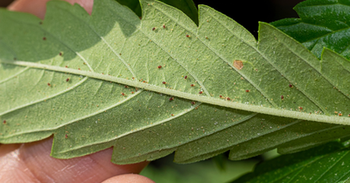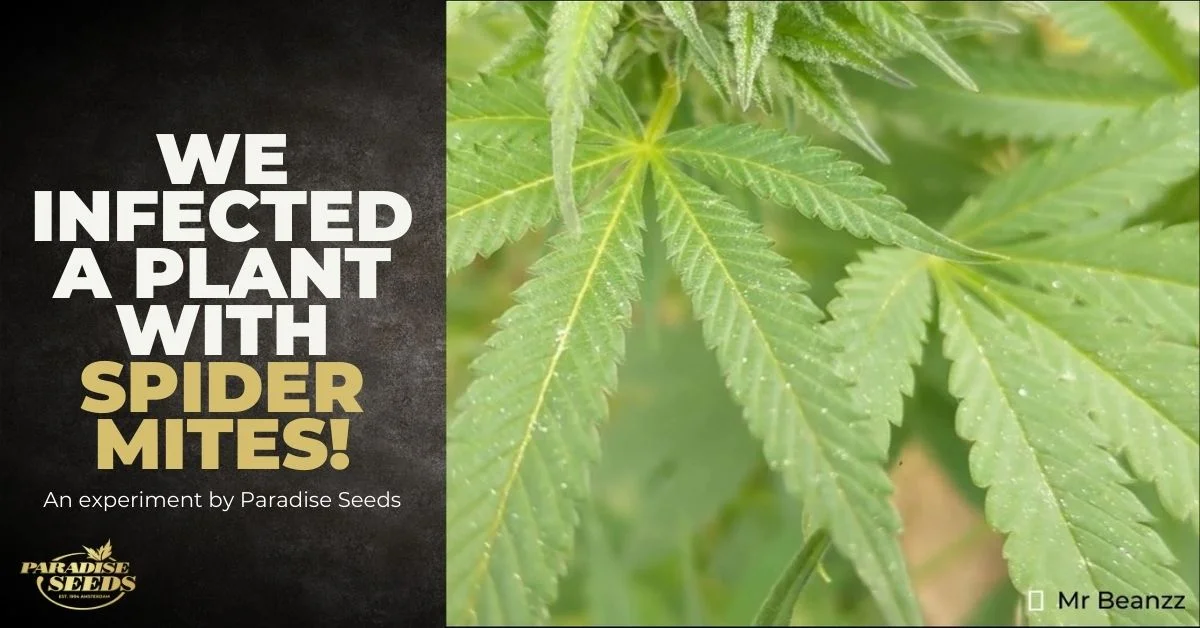Cannabis spider mites infections are a nightmare for any weed grower. The red spider mite (aka two spotted mite or Tetranychus urticae) is often too small to see without the aid of a magnifying glass, has a fearsome reputation for the destruction of cannabis crops.
Most articles you will read about spider mites will naturally focus on treatments for their removal. What all of these articles share in common is the warning that unless an infestation is dealt with, that cannabis crop you have been nurturing so lovingly will be destroyed. This article is different because we purposely promoted a cannabis plant spider mite infestation and watched to see what would happen!
Contents
Cannabis Spider Mites Experiment
Within the confines of an indoor grow room cannabis plants are vulnerable to any pests brought into its sealed chamber and yes, our advice is still to panic if you are an indoor weed grower with a spider mite infestation… However, if you are growing outdoors, or in a greenhouse/polytunnel then this experiment may be useful for you.
Stage 1: The Hunch
The aim of the experiment was to see if – with a little bit of help – nature would bring some balance to the situation. In nature pests and predators live side by side after all, and one organism’s predator is another organism’s food. The question was not ‘will spider mites cause damage to a weed plant?” (of course they would!), but rather ‘how much damage will spider mites cause to a weed plant?’.

Stage 2: The Set Up
Spider mites usually become a problem for outdoor growers in the height of summer, when conditions become dry. This is particularly so in greenhouses and polytunnels where moisture wicks away quickly in the heat of summer days. The other issue with these grow sites is that spider mite populations will often dig in and call the place home – hibernating through the winter to re-merge next year to procreate, reproduce and feast on the new season’s offerings.
This was the case with our test site, a small polytunnel with a recurring spider mite problem. The soil was on the acidic side (iron sulphate added to bring the pH down) and fertilized with manure and seaweed. During the grow it was fed with Biobizz (Grow/Bloom/Top Max) as well as extracts of compost tea in veg stage. High nitrogen levels have been associated with pest infestations , although in this case the spider mite population was indigenous to the environment and a known variable.
Two varieties were planted in the earth – L.A. Amnesia and Spoetnik #1 – at a distance of 1 -2 meters apart. And so these two plants grew for two and a half months before the uninvited guests started to turn up (at the end of July), with increasing numbers of pin-prick white spots appearing on larger fan leaves.
*At this point, it is worth observing that while the aim of the experiment was not to test resistance, the spider mites totally avoided the L.A. Amnesia and decided to call Spoetnik their summer home…
Stage 3: Aid package
Predators: Paradise Seeds is a big fan of using biological pest control solutions . One of the non-toxic remedies recommended for a spider mite infestation on a cannabis plant is the use of predator mites such as Phytoseiulus persimilis (a reactive predator to feast on existing populations) or Amblyseius californicus and Amblyseius andersoni (which can be introduced in anticipation of an attack as they can survive for a while without food). Therefore one order of Phytoseiulus persimilis was added to the plant in an attempt to bring some natural balance.
Moisture : Spider mites thrive in dry hot conditions but don’t do so well when it’s wet, so a good soaking each day with a garden sprinkler helped to maintain a moist and unwelcome atmosphere for them. However, when the plants went into flower at the end of August water soaking was scaled back for fear of promoting bud mold.
Stage 4: Observation
We won’t lie, it wasn’t pretty sitting back and watching spider mites let rip on a beautiful cannabis plant, and there were several moments when the wisdom of the experiment was questioned… Nevertheless, despite extensive leaf damage, Spoetnik was still producing buds, and they were more impressive than we had anticipated.
Stage 5: Equilibrium
As the plant approached harvest in early to mid October, spider mite damage began to slow. This is likely to be the result of cooling temperatures(at temperatures below 25° spider mites stop breeding) and more Autumn moisture in the air, or perhaps it was a sign that the predator mites were gaining the upper hand. Regardless, the damage never reached the fatal point of no return (no large scale web network) and interior leaves actually escaped the kind of beating the exterior fan leaves had taken.
Stage 6: A Helping Hand
Two weeks before harvest, pruning took away the most badly infected leaves.
Stage 7: Harvest
Once harvested, the buds were dry trimmed to take away any leaves and hung – testing the theory that, once there is no living plant /leaf matter to feast on, then there is no reason for the spider mites to stay around. In this case… point proven. Despite all the stress of a spider mite situation, the buds of the Spoetnik plant were surprisingly healthy and the yield was a pleasant surprise – 81 gms
So, what did this experiment prove? That spider mites love cannabis plants (no surprise!) and they will do damage (no surprise). However, with a little bit of help, nature will often bring some equilibrium (outdoors at least). So the moral of this story is pest management is perhaps an avenue to explore rather than follow the often prescribed route of ‘scorched earth’ eradication. Yes it’s a leap of faith, but if you have a recurring pest problem, it’s sometimes good to think outside of the pot…



